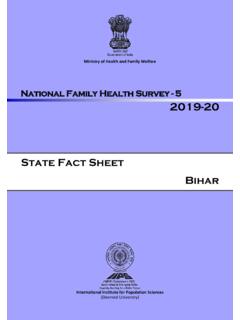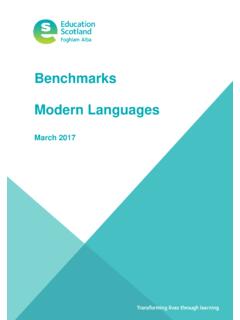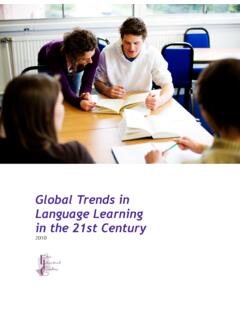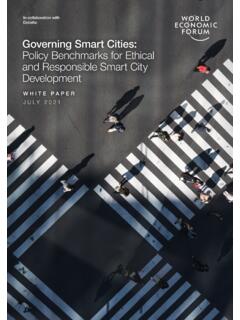Transcription of Age and Generation-specific use of language
1 Age and Generation-specific use of language Jenny Cheshire Queen Mary, University of London 1. Concepts, terminology and overview The relation between the ageing process and language use has traditionally been analysed from two points of view: the changing language used during the lifespan of an individual, and the language of different cohorts of individuals living within a speech community. Age-specific use of language refers to the first approach, with Generation-specific use of language reserved for the latter. The distinction has been an important one in the analysis of language change, for if we assume, with Labov (1994, 107) that individuals tend to preserve their speech patterns as they move through their lifespan, then the study of Generation-specific language necessarily involves the study of language change.
2 However, it is not always possible to clearly separate the concepts of age and generation since, as Eckert (1997, 151), points out age and ageing are experienced both individually and as part of a cohort of people who share a life stage, and/or an experience of history . The analysis of age and Generation-specific use of language used to be seen as relatively straightforward, but a series of publications since the 1990s have problematised this area of research and put into question distinctions that had previously been taken for granted. Eckert (1997, 156) highlights the distinction between chronological age, or the number of years since birth, biological age, or physical maturity (which does not necessarily, of course, correlate exactly with chronological age), and social age, which is tied to life events such as family status (including marriage or birth of first child) or legal status (Eckert gives as examples naturalization or date of first arrest).
3 Coupland and his colleagues use contextual age in much the same way as social age (Coupland 1997, 34). In western societies chronological age is usually the starting point for research on age and Generation-specific use of language , but for societies elsewhere in the world this may be impossible. In the African context, for example, people may not know their absolute chronological age: if they are asked for their age, the clerk of the tribal authority may assign one based on physical appearance (van Eeden 1991, 33, cited in Makoni 1997, 61). In some communities social rituals may be more important benchmarks than the year of birth.
4 Thus for some rural Xhosa men their own initiation sequences relative to other men's are the basis for social categories relevant to the concept of age. Women and men cannot be categorised in the same way in this society, however, since for women the relevant age-related social categories involve marital status, with widows who do not remarry assuming an important role that is otherwise restricted to men (ibid.). This point is valid generally, because in all societies gender and other relevant social variables interact with the age variable, however it is defined, making comparisons between different age groups far from straightforward.
5 Age may be a more meaningful social category in some cultures than in others. Ota, Harwood, Williams and Takai (2000, 34) found that for 18-19 year olds a group identity in terms of age was stronger for Americans than for Japanese. Furthermore, being young appeared to be a more positive experience overall for the young American adults: the young Japanese in the sample were more ambivalent about their experiences of being young than were the young Americans. The authors relate this finding to the social changes currently underway in Japan, where there is a gradual shift of culture from traditionalism to a more modern or western culture in which being young is a more positive and more powerful life stage.
6 More is known about the language used at some life stages than at others. There has been more research on the language of childhood and adolescence than on the language of the middle years an unfortunate state of affairs given the middle-aged bias that exists in work on age and Generation-specific use of language (and, indeed, in social science research generally (Eckert 1997, 157)). Eckert (ibid) points out that only the middle- aged are seen as engaging in mature use, as doing language rather than learning it or losing it . The research of Giles and his research associates in eleven countries (Giles et al.)
7 2000) can be seen as confirming the vitality of middle age. In a series of experiments involving undergraduate students they found middle aged people to have greater ethnolinguistic vitality than younger or older people (the mean age seen as marking the onset of middle age was around 31, with 52 the mean for the onset of old age, though there was some cross-cultural variation between eastern and western countries ( , 319)). Vitality was measured by a version of the Subjective Ethnolinguistic Vitality Questionnaire (see Bourhis et al. 1981), which includes items assessing judges'. perceptions of young, middle-aged and older adults in terms of their strength in areas such as government, education and business institutions, and their social prestige and influence.
8 The high profile of the middle-aged presumably explains why researchers have implicitly seen their language as a standard against which the language of both older and younger speakers can be measured. Thus children's language has been conceptualised in developmental terms, with adult language seen as the target; conversely, the language of the elderly has been analysed as a degeneration and decline from the middle-aged adult norm. It is becoming recognised, however, that adult language , as well as child language , develops in response to important life events that affect the social relations and social attitudes of individuals.
9 There is a move to analysing the speech of members of a given age group as fully appropriate to that life stage rather than comparing it either implicitly or explicitly to the language of the middle years. In this vein Sealey (2000) marks an innovative approach to child language , analysing the language used to represent and construct' children in contemporary British culture and exploring how the social status of being a child is represented in the language used by and to children. The work of Coupland and his colleagues takes a discourse-based approach to the analysis of the language of the elderly and of language and ageing in general (see, for example, Coupland Coupland and Giles 1991).
10 Paoletti (1998) examines the social construction of older women's identities in Italy. Both the older and the younger stages of the life span are beginning to be explored in detail, then: but detailed research on the important period of middle-age remains to be done. 2. Age grading Age-grading refers to a change of behaviour with age that repeats itself in each generation. Some writers use the term to refer only to language used by children that is repeated in every generation without ever being used by adults (see Hockett 1950, 423), such as children's skipping chants or terms used in childhood games (see, for some of these terms, Bauer and Bauer 2000).








